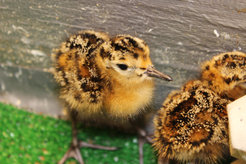Alternative Reproductive Tactics in Birds: how to overcome a Ruff handicap

APPLICATION DEADLINE CLOSED JAN 15!
How does behavioural diversity persist over time? The Ruff Philomachus pugnax is a charismatic shorebird with multiple male mating tactics that profoundly differ in display behaviour, aggression and male ornamental plumage. The differences are best visible in males during the breeding season where three morphs can be identified: (i) Independents, large aggressive Ruffs with dark plumage ornaments, who fight other Independents over matings with females; (ii) Satellites, non-aggressive Ruffs with pale plumage ornaments that co-display with Independents and (iii) Faeders, small non-aggressive Ruffs who lack plumage ornaments and actively distract ornamented males from matings whilst stealthily attempting to steal matings with females themselves. Remarkably, these reproductive tactics are fully genetically determined and the three morphs appear to occur in stable frequencies in nature.
We recently found that the underlying genetic differences are entirely encapsulated within a chromosomal inversion region on chromosome 11. This region comprises less than 0.5% of the Ruff genome. This inversion variant is homozygous lethal since one breakpoint interrupts the gene CENPN, whose product is required during mitosis. In addition, long time data from aviary breeding suggest that carrying an inversion allele increases juvenile mortality and therefore the inversion provides a genetic handicap. Our detailed knowledge about the genomic differences has made it possible to develop new diagnostic tools to determine morph frequencies in nature that we want to use to advance our understanding about the persistence of this unusual behavioural diversity and illuminate how the genetic handicap is compensated for.
We are seeking a PhD candidate who will take a demographic modeling approach to help us understanding, how the three morphs co-exist in nature. The project will provide opportunities to do fieldwork and sample Ruffs in different parts of Europe, carry out moleculargenetic work (SNP genotyping) and advanced demographic modeling. The student will then integrate already collected data from captivity and the wild with newly collected data and construct a series of state-of-the-art population-matrix models. These models will provide critical morph- and sex-specific parameter estimates, which as such cannot be obtained otherwise. The insights from the modelling will advance our understanding about the maintenance of phenotypic diversity in a textbook example for sexual selection. It will complement other research currently carried out in our group aiming to unravel the proximate mechanisms underlying the three morphs.
Keywords mating behaviour, alternative reproductive tactics, evolutionary stable strategies, evolutionary genetics, supergene, demographic models
Supervisors Clemens Küpper, MPIO Seewiesen, Susanne Schindler, U Bristol
